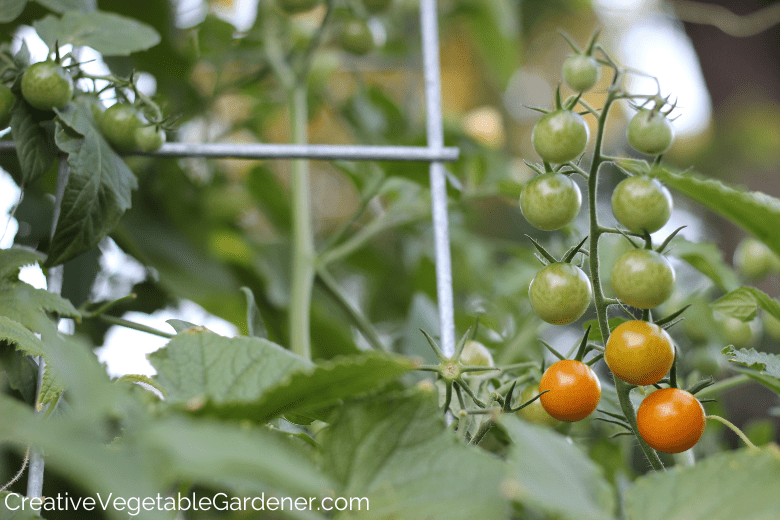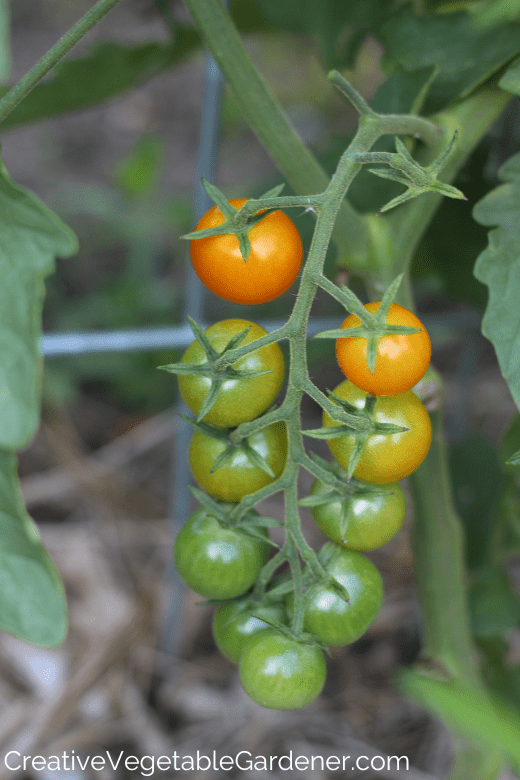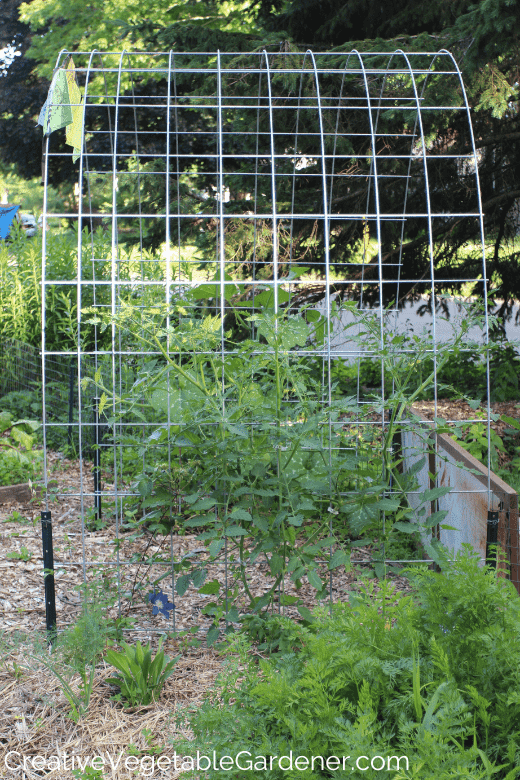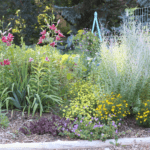
If I had to pick one variety of tomato to grow I would be hard pressed to make a decision. Would I skip the production and flavor of a classic paste tomato like Amish Paste? Or would I ignore the delicious flavor and beautiful color of the solid slicer Moonglow?
I do know one thing, if I had to choose just one variety of cherry tomato there would be no debate in my mind. Sun Gold is my hands down favorite cherry tomato. Growing Sun Golds in my garden is the closest I will ever come to having a living candy machine in my yard. They are as sweet as they are prolific.
When cherry tomatoes start to ripen, the first tomato you harvest is like a precious gift. Eventually, you are getting showered with these gifts and need to make sure your candy machine isn’t dropping treats all over the ground. Cherry tomatoes are fun to grow because each plant can produce hundreds of fruit.
This can also be potentially stressful if you’re not used to growing this type of tomato. Knowing when to pick cherry tomatoes will keep you from missing ripe fruit and prevent wasted fruit from rotting at the base of your plants.
In this article, you’ll learn tips for when to pick cherry tomatoes at just the right time, some critical information about the plant, and what to do with the bowls full of fruit when the plant is at its peak.
Picking Cherry Tomatoes: How to Know When They’re Ripe
The first important piece of information is knowing when to pick cherry tomatoes is what color the skin ripens to on the particular variety of cherry tomato you’re growing. Knowing whether your cherry tomato will be red, orange, or yellow when it’s at its peak ripeness is key.
If you’re not sure what color tomato you’re growing, look up the variety on the internet to find out. If you’ve decided to grow my favorite, Sun Gold, the ripe fruit is a bright orange.
When an individual tomato is uniformly it’s ripe color, grab it and give it a little tug. If the fruit is ripe, it should easily release from the plant. If you are having to twist the cherry tomato free, or apply a lot of pressure, the tomato isn’t quite ready.
Tomato cherry harvest will start to pick up in pace as the weather heats up. Checking in daily on your garden is an important task that only gets more critical when the harvest speeds up.
A word of warning: cherry tomatoes have a tendency to develop a crack under certain circumstances. One cause of cracking is too much water. The tomato fruit can become swollen from an abundance of water. This can cause the skin to burst. If your garden gets a big rain storm, or you overwater your cherry tomato plants, you may this happening to many of the ripe fruit.
One downfall of my beloved Sun Golds is that they do seem to crack more than other varieties. One way around this issue is to harvest the tomatoes a bit early before they’re allowed to overripen. In anticipation of a big rain event, I will make a point of going out to my garden and harvesting all of the ripe cherry tomatoes.
Cherry Tomato Plant Height: How Big Do They Grow?
Cherry tomato plants are a bit different than slicers, paste and sauce varieties because they tend to grow much taller. This can make harvesting a challenge as the season progresses.
Luckily, as the popularity of patio and container gardening grows, many seed companies are releasing cherry tomato varieties that have shorter and more compact forms.
Knowing the difference between determinate and indeterminate tomatoes is an important first step when planning out which tomatoes you’re going to grow.
Determinate Tomatoes
Determinate tomato plants have a growth habit that can be of great advantage to a gardener managing a small plot. Tomatoes with determinate genetics are often referred to as bush tomatoes for their smaller stature and bushy shape.
Shorter tomato plants can provide more sun and space for other garden beds and make for a more managed look. Determinate plants can also work well in pots, where trellising can be more challenging.
Determinate tomatoes also tend to have fruit that ripens around the same time, so harvesting and processing can happen over a shorter window. Gardeners with short growing seasons may have improved harvest with determinate varieties that ripen sooner than indeterminate varieties.
If you want to grow a determinate cherry tomato, you may have to look around a bit because while they do exist, they’re more difficult to find. I did a quick search on Johnny’s Selected Seeds website, and they have two determinate varieties, Washington Cherry, Gold Nugget, and BHN 968.
Indeterminate Tomatoes
Unlike determinate tomatoes, which tend to grow to a certain height and then stop, indeterminate tomatoes will keep growing in my Wisconsin garden until I get a frost in October.
Having indeterminate tomatoes growing in your garden will provide a steady and longer window of tomato harvests. Having multiple varieties of indeterminates will guarantee larger and more frequent harvests.
Climbing, or vining is another way indeterminate tomatoes are described. This growing habit will require some level of maintenance, often pruning and trellising.
Pruning your indeterminate tomatoes will help improve airflow and sunlight to the plants. Tomatoes are susceptible to numerous diseases and overgrown plants can lend themselves to fungal disease. Pruning lower branches can reduce soil borne disease from infecting foliage touching the ground and spreading throughout your plants.
Pruning can also help ripen fruit by opening up the interior of the plant to more sunshine and airflow, keeping the fruit and leaves dry. Learning to prune tomato plants can not only keep your plants healthier, it can also promote more fruit production.
Learn more about pruning indeterminate tomatoes in this article with a video of me in my garden.
The majority of cherry tomato varieties tend to be indeterminate. The tips from above about when to pick cherry tomatoes apply to both determinate and indeterminate varieties.
Do Cherry Tomatoes Need Cages?
If you choose to grow an indeterminate cherry tomato, you should definitely grow them in a cage or on a trellis.
If you live in a climate that has long hot summers, your cherry tomatoes can grow like weeds. In my garden, my Sun Gold plants are usually at least 8 feet tall by the end of the season. Having vining plants without enough support can result in diseased plants and smaller harvests. Training your plants to a trellis or cage will help keep the foliage off the ground and make harvesting the fruit an easier and more enjoyable task.
My favorite way to grow cherry tomatoes is with a cattle panel trellis. I love having the plants grow on the arched trellis at the entrance to my garden. I’m less likely to miss any ripening fruits when I walk below fruit that is hanging in front of my nose. In this article I share the different styles and how to easily make your own cattle panel trellis.
Another option, is to use a cage with your cherry tomato plants. Although I do use tomato cages with the other tomatoes I grow in my garden, I’m not big fan of using cages with cherry tomatoes because they get so tall. It’s very difficult to find a tomato cage that is 8 feet tall.
That being said, I have grown cherry tomatoes with cages. I’ve been using the same DIY tomato cages for many, many years.
If you’re new to growing tomatoes, you can learn more about how to use tomato cages and why they’re so important for a successful tomato harvest.

Growing Tomatoes in Containers
Having a spot on your property that gets 6-8 hours of direct sun can be a magical thing because it will allow you to grow some of your own food. Even if you only have a sunny deck or balcony, they can provide the conditions for a small container garden of tomatoes.
Growing cherry tomatoes in containers will take a little more fuss, but having your garden out your back door can be satisfying and convenient. You’re also more likely to know when to pick cherry tomatoes if you see them every day.
Choosing a determinate variety that maintains a bush form will be beneficial for small space production. Determinate cherry tomatoes will have small fruits and thus less weight to support in the form of trellising.
Renee’s Garden Seeds has a few varieties of cherry tomatoes that are best for container growing.
There are also many determinate varieties of paste, slicer and sauce tomatoes. Just know that some determinate varieties can still grow to be 3-4 feet tall, so make sure you read the variety description to make sure that particular tomato matches your container growing situation.
Tomatoes are heavy feeders and require the larger soil volumes that a 5 gallon pot provides. Knowing that your new garden is going to require 5 gallon sized pots for each plant can help determine the number and variety of plants you will want or be able to grow.
Two of the biggest challenges with growing in containers is fertilizer and watering.
Fertilizing
Even though you’re hopefully growing your tomatoes in larger containers, that doesn’t mean your plants will necessarily have enough nutrients. You’ll need to fertilize your plants every 2 weeks or so to keep the foliage looking healthy and the plants well fed to provide larger harvests.
Because you need to water pots every day to keep them from drying out, the nutrients in the soil leeches out over time as the water drains out of the pot on a regular basis. I recommend using an organic garden fertilizer for container growing.
Watering
Remember to keep your pots well watered, though not soggy, because tomato don’t like wet soil. Make sure your container has drain holes. You can also add drainage material like pea gravel or coconut coir to the bottom of the container to keep the roots from sitting in water and developing root rot.
Having a dish to collect any water than drains through the pots will protect surfaces and allow the plants to absorb any excess water in the heat of the day. Hot and/or windy weather will dry pots out quickly and will definitely affect the amount of water your plants will need.

Can You Freeze Cherry Tomatoes?
When harvesting from the various tomato plants in my garden I often create a confluence of varieties on my counter that can’t all be eaten fresh. That when I start putting tomatoes away for winter eating. My favorite, and the fastest, way to preserve tomatoes is cooking them down and then freezing them.
I don’t usually process cherry tomatoes differently than the other varieties I grow. They most often get chopped up and cooked down with the heirloom and paste tomatoes.
You can read all about how to save time preserving tomatoes with this quick hack.
If you’re short on time, you can also freeze cherry tomatoes whole or chopped in quality freezer bags. You can always cook them down into a pasta sauce later, though they do take up way more space when frozen whole.
Read more about freezing tomatoes without cooking them down in this article.
Now that you know exactly when to pick cherry tomatoes, I highly recommend you grow them in your garden this season for many reasons. They tend to be the first ripe tomato in my garden every year, the flavor of a Sun Gold is the sweetest pop of any tomato I’ve ever grown, the plants produce a plethora of fruit, and tomatoes can be easy to preserve if you don’t can them.
I can’t imagine my garden without a few cherry tomato plants. I will always eagerly await the first ripe fruit in early summer and mourn the last harvest when a hard frost brings the growth cycle to a close in fall.
Love tomatoes? Here are some other articles for you!












Comments
Hi! I just thought it was rad that you showed up on my Google feed! You’re famous! Cheers from SW Wisconsin,
Eva from Troy
Hi Eva! Thanks for popping in to say hi. Hope you’re well!